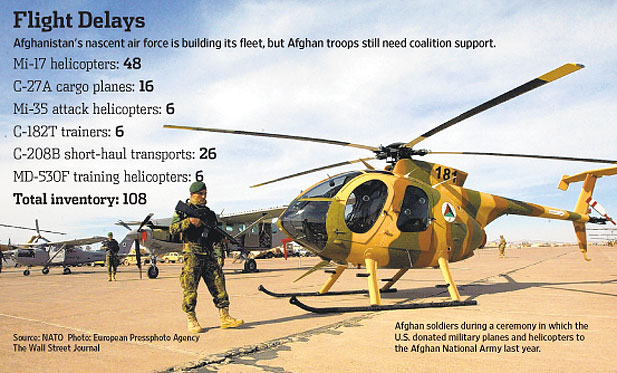
U.S. Grounds Afghan Air Force Plan

Military Ends Transport-Plane Contract, Setting Back Bid to Make Local Forces More Self-Sufficient
The U.S. military said it has scrapped plans to equip the Afghan Air Force with a fleet of Italian-made transport planes, a major setback in an effort to build a more self-sufficient Afghan military as U.S.-led forces withdraw.
Ed Gulick, a U.S. Air Force spokesman, said in an emailed statement that the service on Dec. 18 notified Alenia Aermacchi North America, a unit of Italian defense conglomerate Finmeccanica SpA, FNC.MI -0.87% that a contract to maintain and support 20 refurbished transport planes for the Afghan military wouldn't be renewed when it expires in March because Alenia didn't deliver enough flyable planes.
"This decision comes after failed attempts by the contractor to generate a sufficient number of fully mission-capable aircraft that would provide an effective airlift capability for the AAF," Mr. Gulick said. "Though the Air Force assisted Alenia throughout the program in an effort to help the program succeed, Alenia never achieved key contractual requirements."
At issue is a fleet of C-27A cargo planes, twin-engine aircraft Alenia rebuilt at U.S. taxpayer expense and delivered to Afghanistan's air force. The planes, which were supposed to haul cargo and passengers for the Afghan military, were grounded for several months this year because of lack of adequate maintenance and spare parts, an issue first reported by The Wall Street Journal.
The AAF received the aircraft, also known as the G222, as part of a plan to replace obsolete Soviet-made transport planes beginning in 2009. Mr. Gulick said the U.S. Air Force and Alenia would suspend C-27A flight operations in Afghanistan, determine how to dispose of the existing aircraft and associated spare parts, and close out the contract.
To date, the Air Force has spent around $596 million on the G222 program, including the cost of buying and refurbishing 20 aircraft and maintaining them in Afghanistan.
"We have not received any information that a decision has been made," an Alenia representative said Thursday when asked about the U.S. decision. The representative said the program had shown improvement in recent months: Sixteen aircraft had been delivered out of a planned 20, with an average of eight to 10 aircraft available each day.
"It's all a bit surprising that this decision is being made now when the [remediation] plan is being fully implemented," the representative said.
In a separate statement, Mr. Gulick said that since the most recent grounding of the fleet in March over safety and maintenance concerns, only 10 of the 20 G222s have flown again.
The U.S. decision raises new questions about the coalition's effort to build an Afghan military that will be capable of handling security after the planned withdrawal of most U.S. and international forces after 2014. While Afghanistan has recruited around 187,000 soldiers and 157,000 police, Afghan ground troops depend on U.S. and coalition aircraft to attack insurgents, provide overhead surveillance and ferry wounded service members from the battlefield.
U.S. and Afghan officials now say the Afghan military isn't expected to have an independent and fully functioning air force until around 2017, well after the withdrawal of most U.S. and international troops. Washington and Kabul are in discussions over a residual U.S. military presence that may remain after 2014, and equipment for the Afghan military is likely to be a subject of those negotiations.
The scrapping of the Alenia contract isn't the only setback in equipping the AAF. The Afghan military is in line to receive a fleet of armed attack planes through a separate U.S.-funded effort. The first of those planes was supposed to be delivered well ahead of the U.S. withdrawal, but that program was delayed by a politically charged U.S. procurement contest, and the U.S. Air Force isn't expected to pick a winning design until early 2013.
For now, U.S. and Afghan officers say the AAF must concentrate on the fundamentals. Afghanistan has low literacy rates, making it difficult to recruit personnel who have the right technical skills to fly or maintain planes.
Brig. Gen. Steven Shepro, commander of NATO Air Training Command-Afghanistan, said the AAF is focused on three priorities: resupplying forward bases, moving casualties and transporting the remains of fallen soldiers. He said the Afghans had made strides in recent months to streamline their basic command-and-control and planning procedures.
"What we've seen last month is completely Afghan-led and coordinated missions that have taken place in under five hours, with no advisory input," Gen. Shepro said, describing casualty-transportation missions that once would have taken more than 48 hours to organize with the assistance of coalition advisers.
The Afghan military and the North Atlantic Treaty Organization recently signed a new strategy document that is supposed to outline the goals for building up the AAF next year. AAF commander Maj. Gen. Abdul Wahab Wardak told The Wall Street Journal in an interview that he hoped the strategy would pave the way for a more self-sufficient air force.
"If we try our best and we implement what's in this strategy, we will be ready by 2014," he said, adding: "We will be about 90% or 95% ready for transition."
The AAF operates other transport aircraft. According to NATO, it currently has 48 Russian-made Mi-17 transport helicopters, as well as a fleet of 26 new Cessna C-208B short-haul transports. These types of aircraft carry less cargo than the C-27A, however.
Gen. Wardak said the Afghan government had discussed the possibility of acquiring C-130s, four-engine cargo planes made by Lockheed Martin Corp., LMT -0.95% with the U.S. government
"If we get that, that would be a good capability for our passengers and supply missions," he said.
U.S. officials didn't respond immediately to a request for comment about a potential C-130 procurement for Afghanistan.
Source: By NATHAN HODGE, KABUL - Wall Street Journal News - 27 December 2012
Photo: The Afghan Air Force (Photo by online.wsj.com)
(27.12.2012)
|